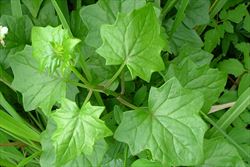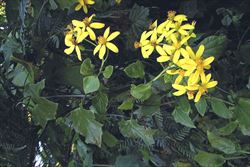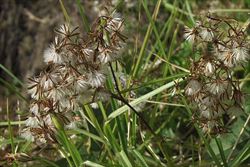Click on images to enlarge

deeply-toothed or slightly-lobed leaves (Photo: Sheldon Navie)

flower-heads (Photo: Jackie Miles and Max Campbell)

mature seed-heads (Photo: Jackie Miles and Max Campbell)
Scientific Name
Senecio tamoides DC.
Family
Asteraceae (Queensland, New South Wales, the ACT, Victoria, Tasmania, Western Australia and the Northern Territory)Compositae (South Australia)
Common Names
canary creeper, Cape ivy, parlor ivy
Origin
Native to southern Africa (i.e. Cape Province and Natal in South Africa).
Naturalised Distribution
This species has a widespread but scattered distribution in eastern Australia. It is relatively common in the coastal districts of New South Wales and south-eastern Queensland, and has also been recorded in northern Queensland.
Notes
Canary creeper (Senecio tamoides) is regarded as an environmental weed in Queensland and New South Wales. This species has escaped cultivation as a garden ornamental, with its seeds being easily dispersal by wind and pieces of its succulent stems often being spread in dumped garden waste. It readily invades native bushland and waterways and can sprawl over the ground or climb high into trees.
This species is currently of most concern in south-eastern Queensland, and it was recently ranked among the 100 most invasive species in this region. As a result of this, canary creeper (Senecio tamoides) also appears on several local weed lists in this region (e.g. is a non-declared pest plant in Redland Shire, an invasive plant in Gold Coast City, and unnacceptable plant species in Burnett Shire, a significant non-declared pest plant in Maroochy Shire, and an undesirable species in Caboolture Shire).
Canary creeper (Senecio tamoides) is also occasionally naturalised in the coastal regions of New Soth Wales, particularly in moist gullies in the Sydney district. It is also an emerging invasive garden escape on the New South Wales South Coast, and has been recorded in conservation areas in this region (e.g. in Berkeley Nature Reserve near Wollongong).

